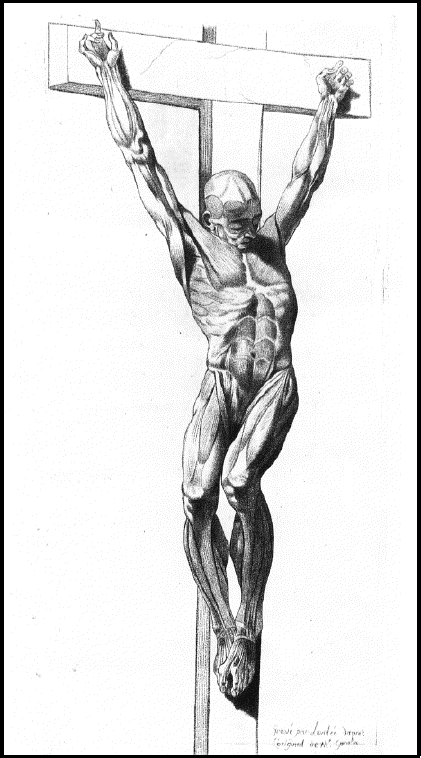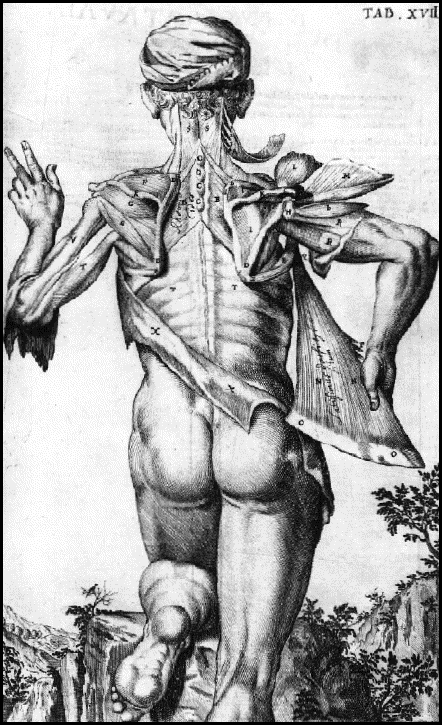A Visual History from
The Renaissance to
The Digital Age
Benjamin A. Rifkin
Michael J. Ackerman
Judith Folkenberg
(Abrams)

- Medical students press through the aromatics of boiled linen, disinfectant, and formaldehyde, making the rounds of formal lectures, half-draped patients, and stripped cadavers. They study the body to improve its fate.
Art students, half-nourished by a miasma of primed linen, turpentine, and chalk, study the undraped model in life class, practice the diagrams of geometric perspective, and memorize the skeleton and muscles in anatomy.
"With kindred presumptions of benefice," concludes the author, "the doctor studies the body to improve its fate; the artist to improve its spirit."
This is no ordinary medical or "art" book. It is a history of the illustrations of "deep" --- and sometimes not-so-deep --- dissections. It contains upwards of three hundred pictures --- mostly woodcuts and engravings --- that were published from the end of the 15th century to the beginning of the 21st.
The design of the book is delicious, if one can use that word with so many illustrations of the "Children of Saturn." The prose is intelligent, wise and penetrating. Likewise, most of the drawings and engravings are clear and rich with detail, often showing a strange sense of modesty. There are twenty-eight important artists featured --- mostly names we have not encountered before: Charles Estienne, Juan Valverdi de Amusco, Bartolommeo Eustachi (you have two of his tubes inserted in your head to protect your ear-drums), William Cheselden (a bone man), William Hunter ... and the improbably named William Smellie. This last created some powerful engravings of fetuses in and sometimes almost out of the uterus --- some of the most disturbing images in the book.
Other interesting monikers include William Skelton who didn't do skeletons but, instead, some fairly ghastly diseased livers, hearts in myocardia, and gangrene; Govard Bidloo, who specialized in neat thoracic cavities, weird fetal skeletons, and shaved heads --- shaved of their outer skin, that is --- including two vile eyes-closed mouth-wide, tongue-extended gack craniums; and Jean-Baptiste Marc Bourgery, whose neck-thorax dissections in vivid color will blow your mind if they don't make you swear off cadaver books for the rest of your days.
It's not only the obscure who appear here. Leonardo da Vinci's "Anatomical Notebooks" are crammed with skeletons and parts of bodies and fetuses "in utero" ... albeit only two included here. There is the "crucified nude" by Jacques Gamelin [Fig. 1 above] that recalls, the author suggests, Michelangelo and Raphael. Rifkin even offers the thought that some of the colorful drawings of "deep dissection" by Jacques Fabian Gautier d'Argoty may have influenced Delacroix and van Gogh.

One of Bildoo's well-endowed ladies offers a lovely view of her backside (I), upper thighs (X) and lower legs (L) ... all rather salacious, I thought. In this regard, the author notes that some of the drawings of Jan van Rymsdyk were painted (like some of Gustave Courbet's) as "genital portraits," suitable for lascivious books of the times. These were drawings so graphic that one critic complained that, although van Rymsdyk worked from nature, "the artist forgot to represent the feet, legs, thighs, stomach, hip, chest, shoulders, arms, hands, throat, neck and head." This graphic illustration is included here.
Benjamin Rifkin's writing is choice, and makes Human Anatomy not only a gold mine of skinned and eviscerated cadavers, but a literary work of some merit as well. This on the sometimes odd positions of the many figures who have been so profoundly filleted:
- The remaining figures may be loosely gathered in groups of the decorous, the demonstrative, and the demented. The decorous are reasonably formed, offering their innards with accommodating modesty like chastened relatives of Berengario's figures. And they are exactly that, for the gift of their cadavers is their penance, an intent demonstrated by the shy deference of their gazes, which look away or down but never meet ours...
In his guide to decorum in art, the sixteenth-century theorist Giovanni Paolo Lomazzo cautioned against unseemly agitation, "the errors of such as give quick motions unto dead parts" in portraying the dead who, as melancholy Children of Saturn, ought to appear with "head declining, eyes fixed upon the earth." The averted glance can be read as shame, a step toward atonement.
By contrast, several cadavers show pride in their work. Eyes on heaven mouths open as if breathing, they stand with fist on hip, elbow out, in an assertive posture of a warrior. It is a pose codified at the end of the sixteenth century in a model book by Jean Cousin the Younger, in use in Baroque body language as a gesture whose meanings range from assurance to arrogance. Demonstrated by a skeleton, the pose suggests the sin of excessive pride, but in this demure context it may well signify the corpse's important value to medicine.